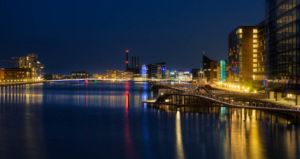News
Copenhagen to turn off lights at 70 landmarks and parks to conserve energy
This article is more than 3 years old.
Measures to affect the Lakes, the Little Mermaid and lots of ‘cross-country’ cycle lanes

So a bit like this, but a whole lot darker (Photo: Jacob Surland)
You might have noticed that the city seems a whole lot darker – and no, the clocks haven’t even been turned back an hour yet!
Many companies and private homes are making widespread efforts to turn off their lights during the hours of darkness, and now Copenhagen Municipality is following suit.
A concerted effort is ongoing under the watchful eye of the Teknik- og Miljøudvalget (technical and environmental committee) at Copenhagen Municipality to ensure the capital uses minimal electricity to light its landmarks and parks at night.
TV2 has obtained a list of 70 places in the capital region that will be considerably darker over the winter (see factbox below): from the Little Mermaid statue to the Lakes, although not every place on the list will be pitch-black.
Lights turned off for five hours
In most cases, lights will be turned off between midnight and 05:00.
The move to save electricity brings Copenhagen into line with a third of the municipalities in the capital region, with more expected to follow suit.
“We are in the middle of a very severe energy crisis: so while we are asking private individuals to reduce energy consumption in their own homes, we are also asking public buildings to reduce energy consumption, and companies to reduce energy consumption,” explained Line Barfod, the mayor for technical and environmental issues, to TV2.
Concerns about safety
However, Copenhagen Municipality received a recommendation just three weeks ago that lights should be turned up during the hours of darkness due to safety concerns. The safety measure failed to find a majority at City Hall.
Not only will many cycle lanes be pitch dark, requiring cyclists to seriously increase the power of their bike lights, but many waterfront walkways will be poorly lit – and they are already treacherous enough for drunken revellers and those unfamiliar with the area.
According to Barfod, the police have been consulted about which parks are safe to turn off the lighting in, and which aren’t. The list obtained by TV2 is partly conditionable on their approval.
“We should consider whether it is possible to take a detour around a park if we have to go home in the middle of the night and there is no light,” she suggested.










































